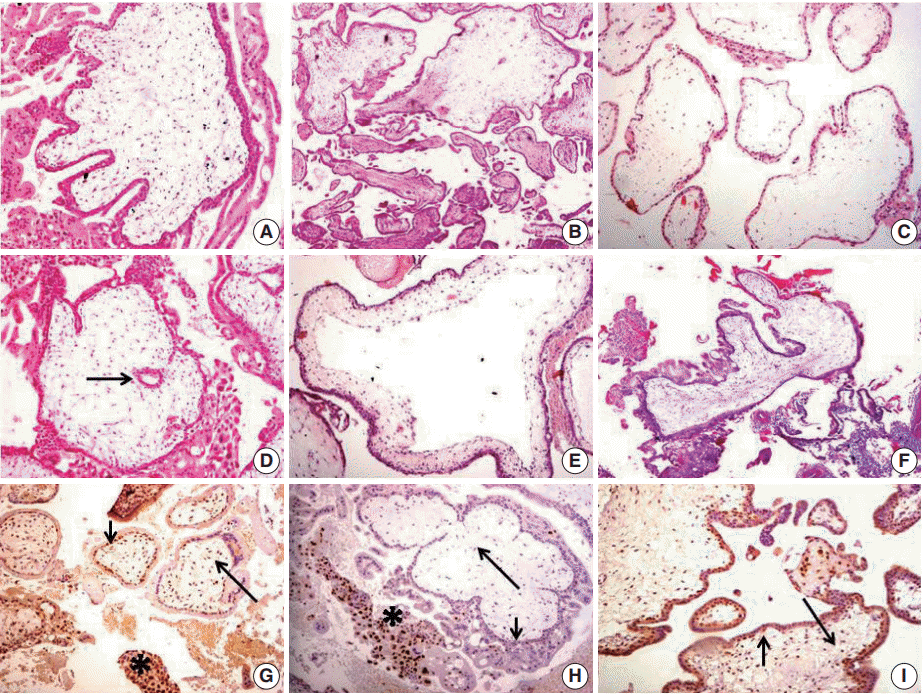Articles
- Page Path
- HOME > J Pathol Transl Med > Volume 51(4); 2017 > Article
-
Original Article
Morphological Features and Immunohistochemical Expression of p57Kip2 in Early Molar Pregnancies and Their Relations to the Progression to Persistent Trophoblastic Disease - Marwa Khashaba, Mohammad Arafa,1, Eman Elsalkh1, Reda Hemida2, Wagiha Kandil1
-
Journal of Pathology and Translational Medicine 2017;51(4):381-387.
DOI: https://doi.org/10.4132/jptm.2017.04.28
Published online: June 12, 2017
Department of Pathology, Faculty of Medicine, Port Said University, Port Said, Egypt
1Department of Pathology, Faculty of Medicine, Mansoura University, Mansoura, Egypt
2Department of Obstetrics and Gynecology, Faculty of Medicine, Mansoura University, Mansoura, Egypt
- Corresponding Author Corresponding Author Mohammad Arafa, MD, PhD Department of Pathology, Faculty of Medicine, Mansoura University, 35516 Mansoura, Egypt Tel: +20-50-226-5922 Fax: +20-50-226-3717 E-mail: marafa8@yahoo.com
© 2017 The Korean Society of Pathologists/The Korean Society for Cytopathology
This is an Open Access article distributed under the terms of the Creative Commons Attribution Non-Commercial License (http://creativecommons.org/licenses/by-nc/4.0) which permits unrestricted non-commercial use, distribution, and reproduction in any medium, provided the original work is properly cited.
Figure & Data
References
Citations

- Molecular Basis of Hydatidiform Moles—A Systematic Review
Shadha Nasser Mohammed Bahutair, Rajani Dube, Manjunatha Goud Bellary Kuruba, Rasha Aziz Attia Salama, Mohamed Anas Mohamed Faruk Patni, Subhranshu Sekhar Kar, Rakhee Kar
International Journal of Molecular Sciences.2024; 25(16): 8739. CrossRef - Diagnosis of hydatidiform moles using p57 immunohistochemistry and chromogenic insitu hybridization: A retrospective study
Mojgan Akbarzadeh-Jahromi, Tara Taheri, Fatemeh Sari Aslani, Akbar Safaei, Fatemeh Pouraminaee, Marjan Zare
International Journal of Reproductive BioMedicine (IJRM).2024; 22(9): 727. CrossRef - Immunohistochemical expression of BCL-2 in hydatidiform moles: a tissue microarray study
Muna Al-Jabri, Suaad Al-Badi, Hunaina Al-Kindi, Mohammad Arafa
Pathologica.2023; 115(3): 148. CrossRef - Persistent gestational trophoblastic disease following ectopic molar pregnancy
I.N. Voloshchuk, I.V. Barinova, S.N. Buyanova, S.A. Petrakova, N.A. Shchukina, M.V. Mgeliashvili
Arkhiv patologii.2021; 83(1): 44. CrossRef - P57 and Ki-67 expression in hydropic abortion and molar pregnancy
Sylvia A. Ashamallah, Mie A. Mohamed, Hany O. Habashy
Egyptian Journal of Pathology.2017; 37(2): 393. CrossRef
 PubReader
PubReader ePub Link
ePub Link-
 Cite this Article
Cite this Article
- Cite this Article
-
- Close
- Download Citation
- Close
- Figure

Fig. 1.
| Significant criteria differentiating between CHM and PHM | Significant criteria differentiating between molar and nonmolar pregnancy |
|---|---|
| Villous shape and outline: p < .001 | Villous shape and outline: p < .001 |
| Villous trophoblast hyperplasia: p = .001 | Cistern formation: p < .001 |
| Atypia at extravillous trophoblast: p < .001 | Trophophoblastic inclusion: p = .001 |
| Villous trophoblast hyperplasia: p < .001 |
| Method of diagnosis | Case |
p-value | |
|---|---|---|---|
| CHM | PHM | ||
| Haematoxylin and eosin stain | 39 (60) | 17 (26) | < .001 |
| p57Kip2 immunohistochemistry | 45 (69) | 11 (17) | |
| Case | Age (yr) | GA (wk) | Histopathology | p57Kip2 | β-HCG (mIU/mL) | MTX | Response | Second-line treatment |
|---|---|---|---|---|---|---|---|---|
| 1 | 20 | 10 | CHM | Negative | 2907 | 2 | Yes | - |
| 2 | 28 | 4 | CHM | Negative | 1294 | 2 | Yes | - |
| 3 | 29 | 8 | CHM | Negative | 280 | 1 | Yes | - |
| 4 | 48 | 8 | CHM | Negative | 1328 | 3 | No | Hysterectomy |
| 5 | 20 | 12 | CHM | Negative | 4177 | 3 | Yes | - |
| 6 | 29 | 9 | CHM | Negative | 446 | 2 | Yes | - |
| 7 | 19 | 8 | CHM | Negative | 3260 | 2 | Yes | - |
| 8 | 42 | 10 | CHM | Negative | 5000 | 6 | No | EMA/CO |
| 9 | 24 | 8 | PHM | Positive | 4990 | 5 | Yes | - |
| Parameters | PGTD (n = 9) | Non-PGTD (n = 56) | p-value | |
|---|---|---|---|---|
| Villous shape and outline | Distended regular | 1 | 9 | > .99 |
| Distended irregular | 5 | 24 | ||
| Non-distended | 1 | 8 | ||
| Two population of villi (distended and nondistended) | 2 | 15 | ||
| Cistern | Present | 8 | 45 | > .99 |
| Absent | 1 | 11 | ||
| Trophoblastic inclusion | Present | 6 | 34 | > .99 |
| Absent | 3 | 22 | ||
| Stromal myxoid change | Present | 4 | 26 | > .99 |
| Absent | 5 | 30 | ||
| Villous trophoblast hyperplasia | Circumfrential | 4 | 21 | > .99 |
| Multifocal | 4 | 27 | ||
| Polar | 1 | 8 | ||
| Stromal karyorrhexis | Present | 0 | 14 | .186 |
| Absent | 9 | 42 | ||
| Atypia at extravillous trophoblast | Mild | 5 | 32 | > .99 |
| Marked | 4 | 24 |
CHM, complete hydatidiform mole; PHM, partial hydatidiform mole.
Values are presented as number (%). CHM, complete hydatidiform mole; PHM, partial hydatidiform mole.
GA, gestational age; β-HCG, β-human chorionic gonadotropin; MTX, methotrexate; CHM, complete hydatidiform mole; EMA/CO, etoposide, methotrexate, actinomycin D, cyclophosphamide, vincristine/oncovine; PHM, partial hydatidiform mole.
PGTD, persistent gestational trophoblastic disease.

 E-submission
E-submission




